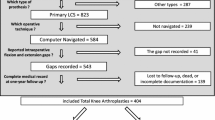Abstract
Purpose
We investigated the relations between flexion balances and functional outcomes after total knee arthroplasty (TKA).
Methods
Sixty-one knees that underwent a TKA were included in this study. Clinical assessments were performed and flexion balances of the knee were assessed on varus and valgus stress radiographs at 90° of knee flexion. Total laxity was defined as the sum of medial and lateral laxities. Knees were divided into balanced (≤3°, n = 51) and unbalanced (>3°, n = 10) groups based on the only difference of mediolateral laxity regardless of total laxity. And the balanced group was divided into Grade I (<6°), Grade II (≥6° but ≤10°) or Grade III (>10°) groups based on the amount of total laxity.
Results
Although no statistically significant differences were observed between the balanced and unbalanced groups in terms of range of motion (ROM) and KS pain scores, the balanced group achieved better results in terms of KS function and WOMAC scores than the unbalanced group. Total laxity was significantly less in the balanced group. In addition, Grade II knees in the balanced group had significantly better KS pain and function scores, and WOMAC scores than Grade Ior Grade III knees.
Conclusions
These results suggest that total knees with good balanced flexion stability can provide good functional outcomes after TKA.



Similar content being viewed by others
References
Unitt L, Sambatakakis A, Johnstone D, Briggs TW, Balancer Study Group (2008) Short-term outcome in total knee replacement after soft-tissue release and balancing. J Bone Joint Surg Br 90:159–165
Peters CL, Jimenez C, Erickson J, Anderson MB, Pelt CE (2013) Lessons learned from selective soft-tissue release for gap balancing in primary total knee arthroplasty: an analysis of 1216 consecutive total knee arthroplasties: AAOS exhibit selection. J Bone Joint Surg Am 95:e152
Seon JK, Park SJ, Yoon TR, Lee KB, Moon ES, Song EK (2010) The effect of anteroposterior laxity on the range of movement and knee function following a cruciate-retaining total knee replacement. J Bone Joint Surg Br 92:1090–1095
Song IS, Sun DH, Chon JG, Jang SW, Sun DH (2014) Results of revision surgery and causes of unstable total knee arthroplasty. Clin Orthop Surg 6:165–172
Besson A, Brazier J, Chantelot C, Miqaud H, Gouqeon F, Duquennoy A (1999) Laxity and functional results of Miller-Galante total knee prosthesis with posterior cruciate ligament sparing after a 6-year follow-up. Rev Chir Orthop Reparatrice Appar Mot 85:797–802
Fehring TK, Odum S, Griffin WL, Mason JB, Nadaud M (2001) Early failures in total knee arthroplasty. Clin Orthop Relat Res 392:315–331
Sharkey PF, Hozack WJ, Rothman RH, Shastri S, Jacoby SM (2002) Insall award paper. Why are total knee arthroplasties failing today? Clin Orthop Relat Res 404:7–13
Fehring TK, Valadie AL (1994) Knee instability after total knee arthroplasty. Clin Orthop Relat Res 299:157–162
Krackow KA (2003) Instability in total knee arthroplasty: loose as a goose. J Arthroplasty 18:45–47
Takeda M, Ishii Y, Noguchi H, Matsuda Y, Sato J (2012) Changes in varus–valgus laxity after total knee arthroplasty over time. Knee Surg Sports Traumatol Arthrosc 20:1988–1993
Weale AE, Feikes J, Prothero D, O’Connor JJ, Murray D, Goodfellow J (2002) In vitro evaluation of the resistance to dislocation of a meniscal-bearing total knee prosthesis between 30° and 90° of knee flexion. J Arthroplasty 17:475–483
Matsuda Y, Ishii Y, Noguchi H, Ishii R (2005) Varus-valgus balance and range of movement after total knee arthroplasty. J Bone Joint Surg Br 87:804–808
Insall JN, Dorr LD, Scott RD, Scott WN (1989) Rationale of the Knee Society clinical rating system. Clin Orthop Relat Res 248:13–14
Insall JN, Ranawat CS, Aglietti P, Shine J (1976) A comparison of four models of total knee-replacement prosthesis. J Bone Joint Surg Am 58:754–765
Bellamy N, Buchanan WW, Goldsmith CH, Campbell J, Stitt LW (1988) Validation study of WOMAC: a health status instrument for measuring clinically important patient relevant outcomes to antirheumatic drug therapy in patients with osteoarthritis of the hip or knee. J Rheumatol 15:1833–1840
Kanekasu K, Kondo M, Kadoya Y (2005) Axial radiography of the distal femur to assess rotational alignment in total knee arthroplasty. Clin Orthop Relat Res 434:193–197
Stähelin T, Kessler O, Pfirrmann C, Jacob HA, Romero J (2003) Fluoroscopically assisted stress radiography for varus-valgus stability assessment in flexion after total knee arthroplasty. J Arthroplasty 18:513–515
Kuster MS, Bitschnau B, Votruba T (2004) Influence of collateral ligament laxity on patient satisfaction after total knee arthroplasty: a comparative bilateral study. Arch Orthop Trauma Surg 124:415–417
Yamakado K, Kitaoka K, Yamada H, Hashiba K, Nakamura R, Tomita K (2003) Influence of stability on range of motion after cruciate-retaining TKA. Arch Orthop Trauma Surg 123:1–4
Mitts K, Muldoon MP, Gladden M Jr, Padgett DE (2001) Instability after total knee arthroplasty with the Miller-Gallante II total knee: 5- to 7-year follow-up. J Arthroplasty 16:422–427
Edwards E, Miller J, Chan KH (1988) The effect of postoperative collateral ligament laxity in total knee arthroplasty. Clin Orthop Relat Res 236:44–51
Acknowledgment
This study was supported by a grant of the National Research Foundation of Korea funded by the Ministry of Education, Science and Technology (2014R1A1A2059147).
Conflict of interest
The authors declare that they have no conflict of interest.
Author information
Authors and Affiliations
Corresponding author
Rights and permissions
About this article
Cite this article
Oh, CS., Song, E.K., Seon, J.K. et al. The effect of flexion balance on functional outcomes in cruciate-retaining total knee arthroplasty. Arch Orthop Trauma Surg 135, 401–406 (2015). https://doi.org/10.1007/s00402-015-2159-0
Received:
Published:
Issue Date:
DOI: https://doi.org/10.1007/s00402-015-2159-0




